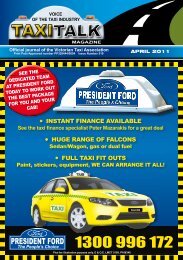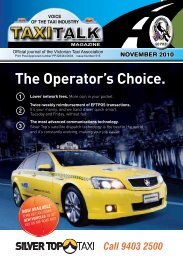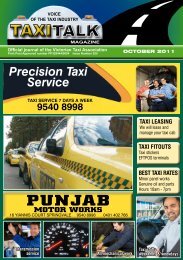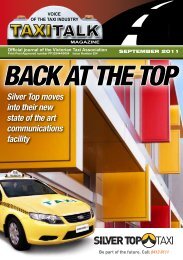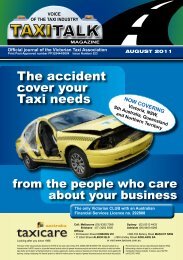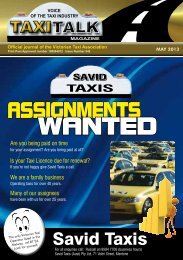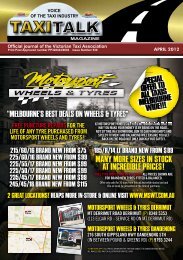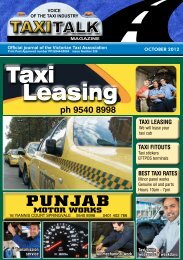Swipe me! - Taxi Talk Magazine
Swipe me! - Taxi Talk Magazine
Swipe me! - Taxi Talk Magazine
You also want an ePaper? Increase the reach of your titles
YUMPU automatically turns print PDFs into web optimized ePapers that Google loves.
<strong>Talk</strong>ing vehicles<br />
may save lives at rail crossings<br />
New technology by La Trobe<br />
University to have cars and trains<br />
‘talking’ to each other could save<br />
an average of 37 lives every year<br />
and an estimated 100 million dollars,<br />
by eliminating rail crossing<br />
collisions, especially in rural and<br />
regional Australia.<br />
The La Trobe system - which<br />
will extend driver ‘vision’ up to one<br />
kilo<strong>me</strong>tre in all directions - will be<br />
trialled in 100 vehicles, the largest<br />
known rail crossing safety study of<br />
its kind in the world.<br />
A $4 million project by the University’s<br />
Centre for Technology<br />
Infusion, in partnership with the<br />
Australian Automotive Co-operative<br />
Research Centre, the Victorian<br />
Depart<strong>me</strong>nt of Transport and<br />
Queensland University of Technology,<br />
intends to have the technology<br />
up and running in three years.<br />
The project is headed by Professor<br />
Jugdutt (Jack) Singh, Director<br />
of the Centre for Technology Infusion.<br />
He says the venture is at<br />
the fore-front of a global move to<br />
‘intelligent’ transport systems and<br />
‘smart cars’ of the future.<br />
It involves dedicated mobilephone-style<br />
wireless networks, integrated<br />
with GPS. These will run<br />
on an international standard of 5.9<br />
gigaherz.<br />
Professor Singh expects new<br />
vehicles will be able to adopt the<br />
technology once this spectrum is<br />
allocated in Australia. It can also<br />
be retrofitted to cars already on the<br />
road.<br />
There are about nine and a half<br />
thousand level crossings on Australian<br />
public roads. About 2,000<br />
are in Victoria.<br />
Professor Singh says drivers<br />
make a staggering number of decisions,<br />
often in split seconds, so<br />
project design also includes University<br />
psychologists for human<br />
factors research.<br />
Depart<strong>me</strong>nt of Transport Senior<br />
Manager Railway Crossing Safety,<br />
Mr Terry Spicer, says the partnership<br />
with La Trobe is helping <strong>me</strong>et<br />
recom<strong>me</strong>ndations made by the<br />
Parlia<strong>me</strong>ntary Road safety Committee<br />
inquiry into improving level<br />
crossings.<br />
‘This technology has the potential<br />
to significantly reduce and ultimately<br />
eliminate collisions, injuries<br />
and fatalities at level crossings,’ Mr<br />
Spicer said.<br />
Professor Singh says traditional<br />
sensors, like radar, have limitations<br />
for advanced transport manage<strong>me</strong>nt<br />
systems. They have a directional<br />
field of view and cannot see<br />
very far into cross roads; and they<br />
are very expensive.<br />
‘By using the latest in wireless<br />
technology we can create 360<br />
degree driver awareness over a<br />
longer range at far cheaper costs -<br />
and at vehicle speeds of up to 200<br />
kilo<strong>me</strong>tres per hour.’ D<br />
40<br />
<strong>Taxi</strong> <strong>Talk</strong> - voice of the taxi industry SEPTEMBER 2010



